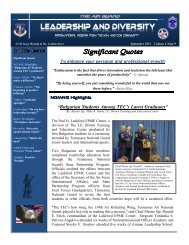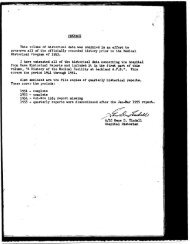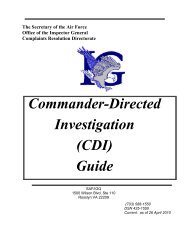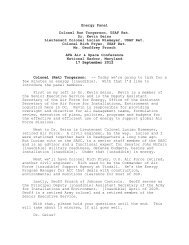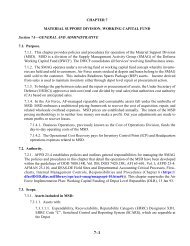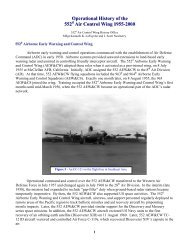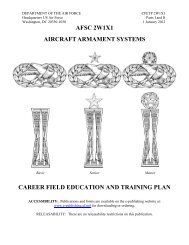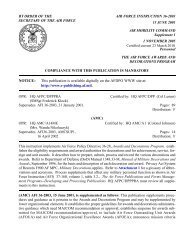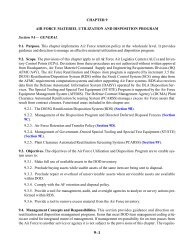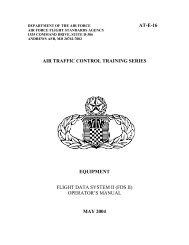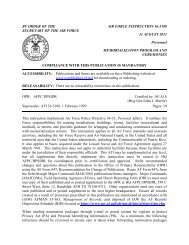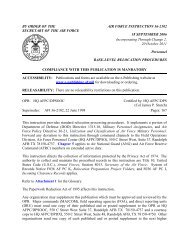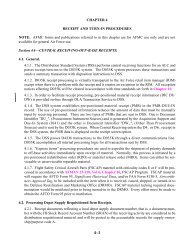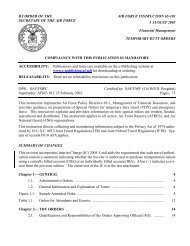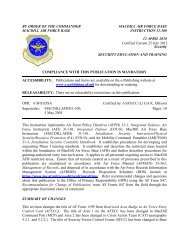MAGAZINE OF THE UNITED STATES AIR FORCE - Air Force Link
MAGAZINE OF THE UNITED STATES AIR FORCE - Air Force Link
MAGAZINE OF THE UNITED STATES AIR FORCE - Air Force Link
You also want an ePaper? Increase the reach of your titles
YUMPU automatically turns print PDFs into web optimized ePapers that Google loves.
When he isn’t transforming<br />
gun parts into guns, Sergeant<br />
McGloin is also a developmental<br />
shooter on the <strong>Air</strong> <strong>Force</strong><br />
National Pistol Shooting Team,<br />
which his shop now supports<br />
by building and maintaining<br />
match-grade pistols. He can<br />
often be found on a firing range,<br />
training for the shooting team’s<br />
next major competition.<br />
The sergeant placed ninth<br />
among marksmen competitors<br />
at the 2010 Pistol and Rifle<br />
Championships at Camp Perry<br />
in Port Clinton, Ohio. The <strong>Air</strong><br />
<strong>Force</strong> team’s next major test is<br />
the inter-service championships<br />
at Fort Benning in June.<br />
“It’s not so much the ability<br />
to shoot,” he said. “You have<br />
to be committed to it, you have<br />
to be dedicated, and you have<br />
to be able to persevere because<br />
there are going to be bad shots.<br />
You have to have the ability to<br />
let the bad shot go and focus on<br />
the next one.<br />
“Focus is extremely huge,<br />
and that’s why Camp Perry<br />
is such a trick because the<br />
environment messes with you<br />
so much,” he said. “You can<br />
have that strong sense of commitment<br />
and determination,<br />
but if a gust of wind comes by<br />
when you get ready to pull that<br />
trigger, your perseverance has<br />
to hold that gun where it needs<br />
to be.<br />
“It’s understanding what you see<br />
down the barrel of your gun and<br />
knowing you’re doing everything you<br />
need to do and knowing it’s going to<br />
be a good shot.”<br />
The <strong>Air</strong> <strong>Force</strong> team only receives<br />
partial support, so the shooters<br />
have to be creative to finance their<br />
own competition and training.<br />
Temporary duty assignments for<br />
competitions like those at Camp<br />
Perry and Fort Benning are only<br />
partially funded, although the Red<br />
Horse Squadron allowed team<br />
members to stay in dormitories at<br />
Camp Perry.<br />
Team members also have to invest<br />
quite a bit, beginning with their<br />
weapons and ammunition, although<br />
the gunsmith shop now helps, as with<br />
the .45 pistols Sergeant McGloin built<br />
for team captain Col. Mark Teskey<br />
and Lt. Col. Thomas Reardon last<br />
year.<br />
“The entry fee to start this sport is<br />
you have to buy a .22, and you have<br />
to buy a .45,” said Colonel Teskey, <strong>Air</strong><br />
<strong>Force</strong> Office of Special Investigations<br />
staff judge advocate at Joint Base<br />
Andrews, Md. “A good match-grade<br />
.45 typically runs between $3,000<br />
and $4,000, and a good .22 is at the<br />
very least about $1,400. So, that’s<br />
about a $6,000 investment because<br />
you’ve also got to buy a gun box and<br />
you’ve got to buy a scope.<br />
“We have to supplement and buy<br />
lead, brass, bullets, primers and a<br />
re-loader, so that’s another several<br />
thousand dollars a year,” Colonel<br />
Teskey said. “The gunsmith shop<br />
supporting us is really a recent thing<br />
and [Sergeant McGloin] is part of that<br />
commitment. That saves the shooter<br />
between $2,000 and $3,000 for a .45.”<br />
Just as Sergeant McGloin had his<br />
mentor, he’s become a mentor for several<br />
local shooters on the Texas State<br />
Rifle Association Junior Team. Rafe<br />
Corley, a student at the University of<br />
Texas at San Antonio, met Sergeant<br />
McGloin on the nearby Medina Base<br />
range in 2009. Since then, Sergeant<br />
McGloin has applied a pistol mechanics<br />
teaching style similar to his gunsmith<br />
mentor’s.<br />
“He’s the kind of teacher who will<br />
tell you to do something a certain<br />
way, then step back and let you do it,”<br />
Mr. Corley said. “If you screw it up,<br />
he’ll just say to do it again. Honestly,<br />
though, I feel that’s the best way to<br />
teach gunsmithing.”<br />
Sergeant McGloin credits Mr.<br />
Corley with helping him improve<br />
his own skills while mentoring the<br />
young shooter on the mechanics<br />
of his pistol. While it might be a<br />
different kind of satisfaction than<br />
building a pistol from a box of parts,<br />
the goal of mentoring is similar.<br />
Ultimately, Sergeant McGloin wants<br />
the shooter and the weapon to do<br />
what they’re supposed to do when<br />
the time comes.<br />
Sergeant McGloin<br />
builds and tests all<br />
of the .45 caliber<br />
handguns the <strong>Air</strong><br />
<strong>Force</strong> National Pistol<br />
Team members use in<br />
competition. Sergeant<br />
McGloin serves as the<br />
team’s noncommissioned<br />
officer in<br />
charge.<br />
May-june 2011 37



